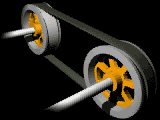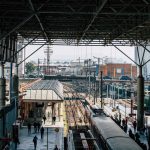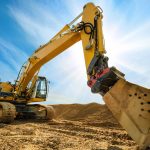Conveyor belt
Jump to navigationJump to search

These conveyor structures contain belts for moving bulk sulfur from railcars to storage piles and from the piles to ships.
A conveyor belt is the carrying medium of a belt conveyor system (often shortened to belt conveyor). A belt conveyor system is one of many types of conveyor systems. A belt conveyor system consists of two or more pulleys (sometimes referred to as drums), with an endless loop of carrying medium—the conveyor belt—that rotates about them. One or both of the pulleys are powered, moving the belt and the material on the belt forward. The powered pulley is called the drive pulley while the unpowered pulley is called the idler pulley. There are two main industrial classes of belt conveyors; Those in general material handling such as those moving boxes along inside a factory and bulk material handling such as those used to transport large volumes of resources and agricultural materials, such as grain, salt, coal, ore, sand, overburden and more.
Contents
Overview[edit]
Conveyors are durable and reliable components used in automated distribution and warehousing, as well as manufacturing and production facilities. In combination with computer-controlled pallet handling equipment this allows for more efficient retail, wholesale, and manufacturing distribution. It is considered a labor saving system that allows large volumes to move rapidly through a process, allowing companies to ship or receive higher volumes with smaller storage space and with less labor expense.
Rubber conveyor belts are commonly used to convey items with irregular bottom surfaces, small items that would fall in between rollers (e.g. a sushi conveyor bar), or bags of product that would sag between rollers. Belt conveyors are generally fairly similar in construction consisting of a metal frame with rollers at either end of a flat metal bed. The belt is looped around each of the rollers and when one of the rollers is powered (by an electrical motor) the belting slides across the solid metal frame bed, moving the product. In heavy use applications the beds which the belting is pulled over are replaced with rollers. The rollers allow weight to be conveyed as they reduce the amount of friction generated from the heavier loading on the belting.
Belt conveyors can now be manufactured with curved sections which use tapered rollers and curved belting to convey products around a corner. These conveyor systems are commonly used in postal sorting offices and airport baggage handling systems. A sandwich belt conveyor uses two conveyor belts, face-to-face, to firmly contain the item being carried, making steep incline and even vertical-lift runs achievable.
Belt conveyors are the most commonly used powered conveyors because they are the most versatile and the least expensive.[citation needed] Product is conveyed directly on the belt so both regular and irregular shaped objects, large or small, light and heavy, can be transported successfully. These conveyors should use only the highest quality premium belting products, which reduces belt stretch and results in less maintenance for tension adjustments. Belt conveyors can be used to transport product in a straight line or through changes in elevation or direction. In certain applications they can also be used for static accumulation or cartons.
-
Belt conveyor systems at a Packing Depot
-
Baggage Handling Belt Conveyor systems
-
Belt conveyor from an open-pit lignite mine in Bavaria
History[edit]
Primitive conveyor belts were used since the 19th century. In 1892, Thomas Robins began a series of inventions which led to the development of a conveyor belt used for carrying coal, ores and other products.[1][2] In 1901, Sandvik invented and started the production of steel conveyor belts. In 1905 Richard Sutcliffe invented the first conveyor belts for use in coal mines which revolutionized the mining industry. In 1913, Henry Ford introduced conveyor-belt assembly lines at Ford Motor Company‘s Highland Park, Michigan factory.[3] In 1972, the French society REI created in New Caledonia the longest straight-belt conveyor in the world, at a length of 13.8 km. Hyacynthe Marcel Bocchetti was the concept designer.[citation needed]
In 1957, the B. F. Goodrich Company patented a Möbius strip conveyor belt, that it went on to produce as the “Turnover Conveyor Belt System”. Incorporating a half-twist, it had the advantage over conventional belts of a longer life because it could expose all of its surface area to wear and tear. Such Möbius strip belts are no longer manufactured because untwisted modern belts can be made more durable by constructing them from several layers of different materials.[4] In 1970, Intralox, a Louisiana-based company, registered the first patent for all plastic, modular belting.
Structure[edit]
The belt consists of one or more layers of material. It is common for belts to have three layers: a top cover, a carcass and a bottom cover. The purpose of the carcass is to provide linear strength and shape. The carcass is often a woven or metal fabric having a warp & weft. The warp refers to longitudinal cords whose characteristics of resistance and elasticity define the running properties of the belt. The weft represents the whole set of transversal cables allowing to the belt specific resistance against cuts, tears and impacts and at the same time high flexibility. The most common carcass materials are steel, polyester, nylon, cotton and aramid (a class of synthetic fiber that includes Kevlar) . The covers are usually various rubber or plastic compounds specified by use of the belt.
Steel conveyor belts are used when high strength class is required. For example, the highest strength class conveyor belt installed is made of steel cords. This conveyor belt has a strength class of 10.000 N/mm and it operates at Chuquicamata mine, in Chile.[5] Polyester, nylon and cotton are popular with low strength classes. Aramid is used in the range 630 – 3500 N/mm. The advantages of using aramid are energy savings, enhanced lifetimes and improved productivity.[6][7] As an example, a 2250 N/mm, 3400 m long underground belt installed at Baodian Coal Mine, part of in Yanzhou Coal Mining Company, China, was reported to provide energy savings of >15%.[8]
Applications[edit]
Today there are different types of conveyor belts that have been created for conveying different kinds of material available in PVC and rubber materials. Material flowing over the belt may be weighed in transit using a beltweigher. Belts with regularly spaced partitions, known as elevator belts, are used for transporting loose materials up steep inclines. Belt Conveyors are used in self-unloading bulk freighters and in live bottom trucks. Belt conveyor technology is also used in conveyor transport such as moving sidewalks or escalators, as well as on many manufacturing assembly lines. Stores often have conveyor belts at the check-out counter to move shopping items. Ski areas also use conveyor belts to transport skiers up the hill. Industrial and manufacturing applications for belt conveyors include package handling, trough belt conveyors, trash handling, bag handling, coding conveyors, and more.[9]
Some of the major global conveyor belt manufacturers and service providers are Berndorf AG, Continental AG, Fenner plc, Kale Conveyor, Terra Nova Technologies, ThyssenKrupp, HESE Maschinenfabrik GmbH and Tenova Takraf. [10]
Long belt conveyors[edit]

Taranto, Paolo Monti, 1964
The longest belt conveyor system in the world is in Western Sahara. It was built in 1972 by Friedrich Krupp GmbH (now thyssenkrupp) and is 98 km (61 mi) long, from the phosphate mines of Bu Craa to the coast south of El-Aaiun.[11]
The longest conveyor system in an airport is the Dubai International Airport baggage handling system at 63 km (39 mi). It was installed by Siemensand commissioned in 2008, and has a combination of traditional belt conveyors and tray conveyors.[12]
Boddington Bauxite Mine in Western Australia is officially recognised as having the world’s longest and second-longest single belts with a 31-kilometre-long (19 mi) belt feeding a 20 km (12.5 miles) long belt. This system feeds bauxite through the difficult terrain of the Darling Ranges to the Worsley Alumina refinery. The longest single-belt international conveyor runs from Meghalaya in India to a cement factory at Chhatak Bangladesh.[13][14][15] It is about 17 km long and conveys limestone and shale at 960 tons/hour, from the quarry in India to the cement factory (7 km long in India and 10 km long in Bangladesh). The conveyor was engineered by AUMUND France and Larsen & Toubro. The conveyor is actuated by three synchronized drive units for a total power of about 1.8 MW supplied by ABB (two drives at the head end in Bangladesh and one drive at the tail end in India). The conveyor belt was manufactured in 300-meter lengths on the Indian side and 500-meter lengths on the Bangladesh side, and was installed on-site by BeltPro (formerly NILOS India). The idlers, or rollers, of the system are unique[citation needed] in that they are designed to accommodate both horizontal and vertical curves along the terrain. Dedicated vehicles were designed for the maintenance of the conveyor, which is always at a minimum height of 5 metres (16 ft) above the ground to avoid being flooded during monsoon periods.
Belt conveyor safety system[edit]
Conveyors used in industrial settings include tripping mechanisms such as trip cords along the length of the conveyor. This allows for workers to immediately shut down the conveyor when a problem arises. Warning alarms are included to notify employees that a conveyor is about to turn on. In the United States, the Occupational Safety and Health Administration has issued regulations for conveyor safety, as OSHA 1926.555.[16]
Some other systems used to safeguard the conveyor are Belt Sway Switches, Speed Switch, Belt Rip Switch and emergency stops. The belt sway switch will trip out the conveyor if the belt starts losing its alignment along the structure. The speed switch will trip the belt if the switch is not registering that the belt is running at the required speed. The belt rip switch will trip the belt when there is a cut, or a flap indicating that the belt is in danger of further damage. An emergency stop may be located on the conveyor control box in case of trip chord malfunctions.














I loved how you said that they are reliable and durable. My husband was telling me yesterday afternoon at lunch about how he has been thinking about using a conveyor belt at his warehouse. I’ll make sure to pass this information along to him so that he can learn more about the benefits of using one.
It captivated me the most when you shared that conveyors used in industrial production possess tripping mechanisms that allow workers to quickly turn off the conveyor when a problem occurs. My friend told me that the conveyor belt they are using needs to be vulcanized. I think they should turn to a company that specializes in conveyor belt vulcanizing to achieve high precision.
It’s interesting to know how conveyor systems have safety features that stop them during an emergency. I think that my cousin wants to start a manufacturing company next year, so he’s currently researching packaging equipment, and I think he’d learn a lot from your article. I appreciate your information on how conveyor systems must follow OSHA’s safety regulations.
orapelengkoloi66@gmail.com